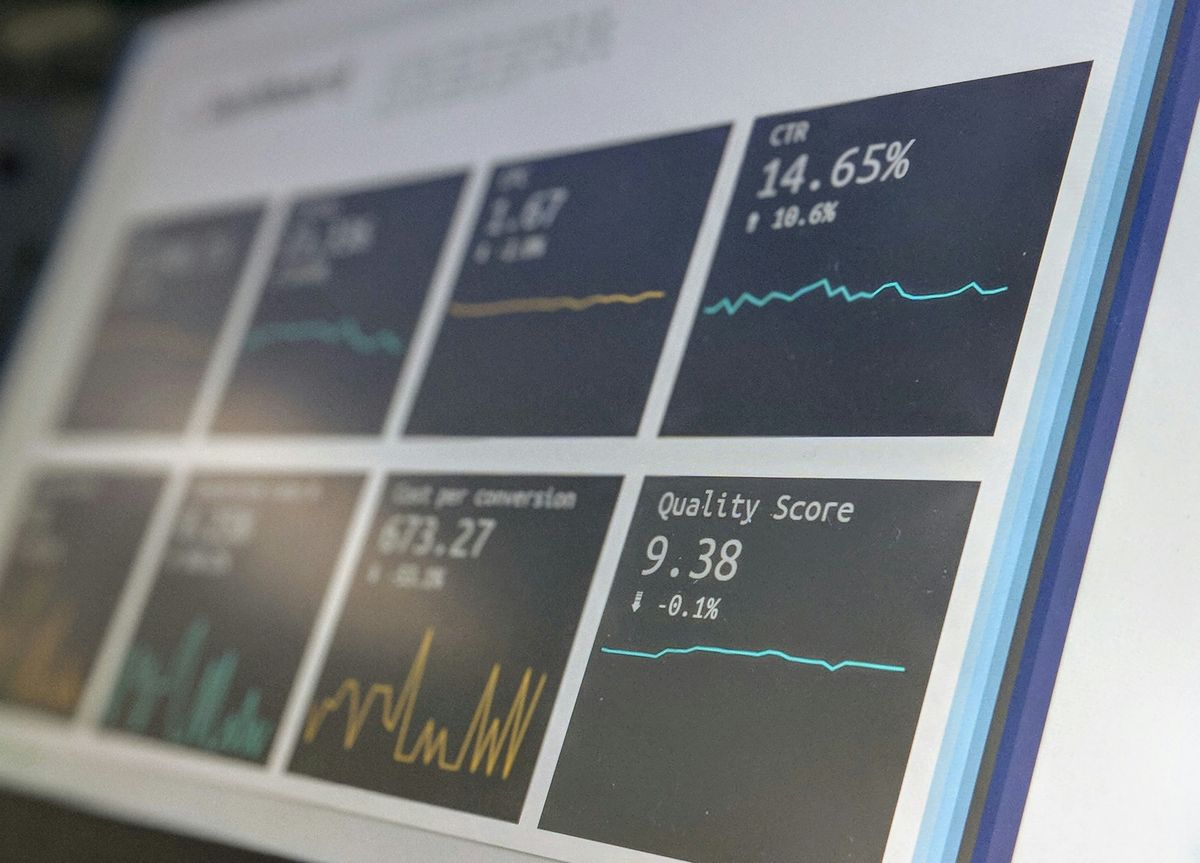Analyzing Competitor Website Traffic Trends
In the digital age, understanding your competition is crucial. It's not just about knowing their products or services.
It's about analyzing their online performance.
This includes their website traffic trends. By comparing your website traffic to your competitors', you can gain valuable insights.

These insights can help you improve your own strategies. You can learn from their successes and avoid their mistakes.
This guide will walk you through the process. It will cover everything from choosing the right traffic analysis tools to interpreting the data.
By the end, you'll be equipped to analyze competitor website traffic trends effectively. Let's dive in.
The Importance of Competitor Traffic Analysis #
Understanding why competitor traffic analysis matters is the first step. It provides a clear picture of the online competitive landscape. This analysis can reveal opportunities for growth.
Competitor traffic analysis helps you identify trends. These trends can indicate shifts in consumer behavior. Recognizing them early can give you a competitive advantage.

Consider the benefits of understanding competitors' online strategies:
- Identify their top traffic sources.
- Discover high-performing keywords.
- Analyze their strengths and weaknesses.
By knowing where your competitors attract visitors, you can align your strategies accordingly. This alignment can lead to increased web traffic and better marketing ROI.
Moreover, competitor traffic analysis is essential for strategic planning. It enables businesses to benchmark their performance. By comparing your results to competitors, you can set realistic goals. This practice ensures that your business stays on the cutting edge.
Selecting the Right Traffic Analysis Tools #
Choosing the right traffic analysis tools is crucial for effective analysis. With so many options, it can feel overwhelming. However, the right tool can make all the difference.
Begin by identifying your needs. Are you focused on keyword research, user behavior, or conversion tracking? Defining your goals helps narrow down your options.
Another factor to consider is the tool's features. Does it offer real-time data? Can it integrate with other platforms you use? These questions will guide you in selecting the best tool.

Ease of use is also important. A user-friendly interface can save time and reduce frustration. Look for tools that offer tutorials and customer support.
Cost is another consideration. Some tools offer free basic plans but charge for advanced features. Weigh the costs against the benefits to ensure value.
Reliability is key in choosing traffic analysis tools. Read reviews and seek recommendations from industry peers. Their insights can highlight potential shortcomings and strengths.
Here's a list of criteria to consider when selecting:
- Features and capabilities
- Ease of integration
- Cost and pricing model
Finally, test the tool before committing. Many tools offer free trials. This allows you to evaluate whether it meets your needs without a financial commitment.
Overview of Popular Traffic Analysis Tools #
Several traffic analysis tools have gained popularity. Google Analytics remains a favorite due to its comprehensive features. It provides insights into user demographics, sessions, and much more.
SEMrush is another powerful tool. It offers keyword analysis, visibility tracking, and a competitive analysis feature. It caters well to those focused on search engine optimization.

Ahrefs is highly regarded for backlink analysis. It is preferred by those interested in strengthening their link-building strategies. Its vast database makes competitor research efficient.
Each tool has unique offerings. Selecting the right one depends on your specific needs and objectives. By understanding their features, you can make an informed decision that enhances your competitive analysis capabilities.
Key Metrics to Monitor in Traffic Analysis #
Monitoring the right metrics is vital for effective traffic analysis. Knowing which data points matter most helps in understanding website performance. Different metrics offer insights into various aspects of traffic and user behavior.
One key metric is bounce rate. It measures the percentage of visitors who leave after viewing just one page. A high bounce rate may indicate issues with content or usability.
Session duration is another important metric. It indicates how long users stay on your site. Longer sessions often suggest engaging content or effective navigation.

Analyzing traffic sources is essential. It reveals where visitors come from, be it organic, direct, or referral traffic. This knowledge helps refine marketing strategies.
Here's a list of key metrics to focus on:
- Bounce rate
- Session duration
- Traffic sources
- Page views
- Conversion rate
Conversion rate is crucial for understanding how well a site meets its objectives. It indicates the percentage of visitors who complete desired actions. Monitoring these metrics provides a clear picture of what’s working and what needs improvement. By focusing on these data points, businesses can fine-tune their strategies for optimal performance.
Step-by-Step Guide to Performing Competitor Traffic Analysis #
Analyzing competitor website traffic involves several key steps. A structured approach helps in gaining valuable insights. Start by identifying the competitors you want to analyze.
Once you've selected your competitors, choose the right tools for analysis. Traffic analysis tools like SEMrush or SimilarWeb can provide comprehensive data. These tools offer insights into traffic patterns, sources, and user behavior.
After selecting the tools, gather the relevant data. Look for metrics that align with your business goals. Focus on visitor numbers, traffic sources, and engagement metrics.

Next, compare the data with your own site’s metrics. This comparison helps identify strengths and weaknesses. Look for areas where competitors excel, as well as where they underperform.
Here's a basic guide to follow:
- Identify key competitors.
- Select appropriate traffic analysis tools.
- Gather and record data points.
- Compare your site’s metrics with competitors’.
- Analyze results to find opportunities for improvement.
Analyze the sources of competitor traffic. Determine whether their traffic is predominantly organic, direct, or through paid channels. This information is useful for adjusting your marketing strategies.
Pay attention to content that drives traffic. Identify which pages or topics are attracting the most visitors. This can provide ideas for your own content strategy.
Finally, synthesize all findings into actionable insights. Develop strategies based on the data to improve your site's performance. Consistently refining these strategies is key to staying competitive in your niche.
Conducting a thorough competitor traffic analysis uncovers valuable trends and insights. Follow these steps diligently to enhance your online strategy. Adapting based on these insights can give your business a competitive edge.
Understanding Organic vs. Paid Search Traffic #
Organic and paid search traffic are pivotal in competitor traffic analysis. Understanding their roles can enhance strategic decision-making. Each traffic type offers unique advantages and challenges.
Organic search traffic comes from unpaid search results. It is driven by search engine optimization (SEO) efforts. This traffic is often a marker of high-quality content and strong keyword strategies.
Paid search traffic, on the other hand, is derived from advertisements. Platforms like Google Ads allow businesses to target specific keywords. Paid campaigns can yield immediate results, increasing visibility and traffic quickly.

Analyzing the balance of organic versus paid traffic offers critical insights. A competitor with high organic traffic may have strong SEO practices. Conversely, significant paid traffic could signal an aggressive marketing spend.
Knowing how these traffic types contribute to competitors' successes is crucial. It allows businesses to allocate resources effectively, maximizing growth opportunities. An informed approach can help improve both the organic reach and the efficiency of paid campaigns.
Identifying and Analyzing Competitor Traffic Sources #
Determining where competitors' traffic originates is essential for a comprehensive analysis. Various channels drive traffic, each offering distinct benefits. Understanding these sources can provide a competitive edge.
The primary sources typically include:
- Direct visits
- Social media
- Referral links
- Search engines
Each of these channels contributes differently to overall traffic. Direct visits indicate strong brand recognition. Social media can highlight engagement and content popularity.

Referral traffic comes from links on other websites. This reflects strong partnerships or valuable content. Analyzing referral sources reveals potential collaborations or backlink opportunities.
Search engines, both organic and paid, are also crucial. They reflect effectiveness in SEO and advertising efforts. Monitoring search traffic helps understand keyword strategies.
By identifying and analyzing these sources, businesses can refine their strategies. It offers insights into what drives competitors' successes. This information can guide targeted efforts to enhance one's own traffic acquisition. Engaging effectively with these channels ensures a robust online presence and improved website performance.
Benchmarking Your Website Against Competitors #
Benchmarking against competitors is a vital strategy for improvement. It allows businesses to measure their performance. Understanding competitive benchmarks guides strategic adjustments and enhances online presence.
Start by identifying key performance indicators (KPIs). These will vary based on goals and industry. Common KPIs include:
- Monthly unique visitors
- Average session duration
- Bounce rate
- Conversion rate

Analyzing these metrics provides a clear performance picture. Look for trends or gaps that reveal opportunities. Benchmarking helps pinpoint where improvements are needed.
Consider qualitative factors as well. User experience, content quality, and site speed play significant roles. These elements can impact how users engage with a website.
Use competitive insights to drive strategy. Adjust marketing, content, or site design based on findings. Regular benchmarking keeps businesses aligned with market shifts.
Incorporating benchmark insights can lead to superior website performance. It fosters a proactive approach to staying competitive. Regular analysis ensures continuous adaptation and success in the digital landscape.
Leveraging Competitor Traffic Analysis for SEO and Content Marketing #
Competitor traffic analysis is a powerful tool for enhancing SEO and content strategies. Understanding what works for competitors can guide your own decisions. It provides a blueprint for content that resonates with your audience.
Begin by identifying high-performing competitor keywords. These are terms driving significant traffic to their sites. Consider:
- Search volume
- Relevance to your business
- Competitor ranking difficulty

Once keywords are identified, analyze the content structure. Look at the format, tone, and engagement on competitor pages. This insight helps tailor your content to meet audience expectations.
Next, evaluate backlink profiles of competitors. Backlinks are a major SEO factor. See who’s linking to them and why. Aim to earn similar quality links for your site.
Also, assess competitors' content frequency and freshness. Consistent updates may boost engagement and ranking. Develop a regular publishing schedule for your content.
Incorporating competitive insights can refine SEO tactics and strengthen content marketing efforts. By aligning with successful strategies, businesses can improve their visibility and attract more traffic. This approach fosters sustainable growth and a stronger online presence.
Ethical Considerations and Best Practices in Traffic Analysis #
When conducting competitor traffic analysis, ethics must be a top priority. It's crucial to respect competitors' data privacy. Adhere to regulations, avoiding practices that may breach privacy or data laws.
Use only legitimate tools and methods. Avoid scraping or hacking for data, as it violates ethical standards. Stick to publicly accessible information and reputable traffic analysis tools.

Transparency is key in any analysis. Keep stakeholders informed about methods and sources. Following ethical guidelines not only protects your business but also fosters trust. Maintain integrity by adhering to best practices in all traffic analysis activities.
Case Studies: Successful Competitor Traffic Analysis #
Let's explore how traffic analysis can lead to success. A footwear retailer used traffic analysis tools to identify competitor strengths. They discovered the competitor's high conversion pages and optimized their own site accordingly.
An e-commerce brand focused on emerging markets analyzed local competitors. By studying their traffic trends, they adjusted their strategy to align with local preferences. This targeted approach increased their regional market share significantly.

A software company leveraged competitor traffic insights to enhance content strategy. By identifying competitor keywords and popular content, they refined their SEO efforts. This led to improved search rankings and increased website traffic.
Common Pitfalls and How to Avoid Them #
When analyzing competitor traffic, one common mistake is relying on a single data source. Diverse tools provide different insights, and using multiple sources enhances data accuracy.
Ignoring contextual factors is another pitfall. Spikes in traffic might be driven by external factors like promotions or news events. Always consider the broader market context.

Lastly, avoid neglecting privacy regulations during analysis. Ensure compliance with data protection laws to maintain ethical practices. Respect for privacy builds trust and credibility in your analysis process.
Conclusion: Integrating Traffic Analysis into Business Strategy #
Competitor traffic analysis is vital for smart business strategy. By understanding traffic patterns, businesses can tailor their strategies for better performance. This insight informs decisions and fosters growth.
Regular monitoring and adapting based on competitor insights yield real benefits. Stay flexible in approach and consistently refine strategies to align with market trends. Consistency is key to long-term success.

Finally, use competitor traffic findings to enhance all areas of your business. From marketing to customer experience, data-driven strategies enable businesses to stay ahead in the competitive landscape.
